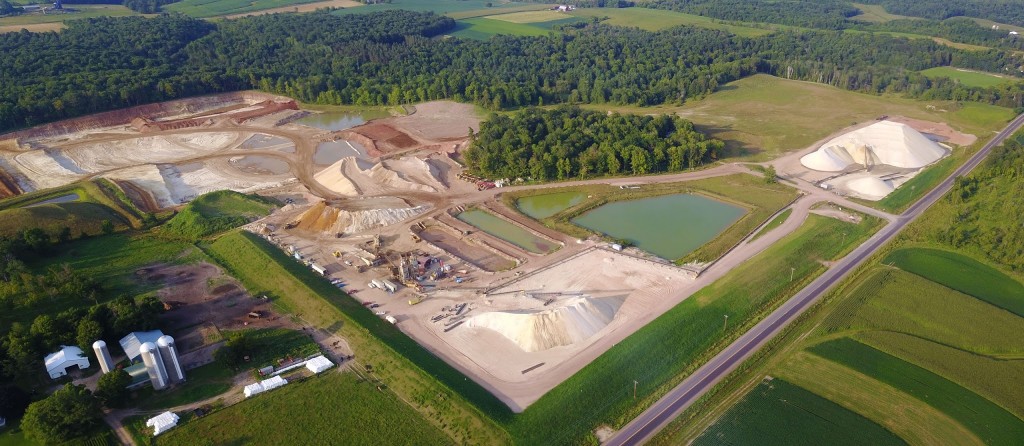From Frac Sand Sentinel, Issue # 329, April 6, 2020
Pause for a moment or two on April 22, 2020. Earth Day was celebrated 50 years ago!
This is the 50th Anniversary of Earth Day! How will it be celebrated? What memories do you have of past civic action? Did you know that in 1972 nearly 2/3 of the lakes, rivers, and coastal waters had become unsafe for fishing or swimming?
Gaylord Nelson, Governor of WI during the 1950’s had passion for environment/ poverty. Residents of Wisconsin joined his concern with the dilapidated state parks, exploiting of public resources by private industry and State’s polluted waterways. He worked to overhaul the DNR to have them focus on conservation, he established the conservation corps and acquired land to be converted into public parks and wilderness areas.
In the 1960’s he became a U.S. Senator. He again built coalitions, fought for environmental issues and through his tenacity Earth Day was created April 22, 1970.
As a U.S. Senator, Nelson championed the legislation below:
1968: National Wild and Scenic Rivers Act (St. Croix River in the original) and by November 2018, 209 Rivers in 40 States protected
1968: National Scenic Trails – There are now 11: WI- *Ice Age and *North Country 4600 miles trek.
1970: Apostle Islands became a National Lakeshore
1972: Clean Water Act
1972: The Federal Pesticides Act was amended
1972: Endangered Species Act was passed.
Currently the Federal Government is focused on rolling back regulations. As of December 19, 2019, 58 rollbacks were completed (16 alone in regards to air pollution and emissions), another 37 in process to make a total of 95 rollback regulations.
Take a moment to pause, think about Mother Earth. How important is clean water and clean air in your family’s life? How important is fishing for you? How about other forms of outdoor recreation and scenic views that you can appreciate? Are you familiar with the Big Blue Marble?
With your family at this particularly vulnerable time, develop a plan to make a difference for our planet that gives life and sustenance, comfort and safe havens for all of us to enjoy. Plant a tree!
Help your children appreciate the value of clean and safe surroundings. Feed the birds! Reduce, reuse and recycle.
Appreciate the works of John Muir, Aldo Leopold, Roscoe Churchill, and other great people including Gaylord Nelson who have written about, spoken about and fought through civic participation and for Mother Earth and her inhabitants.
Participate in civic engagement to protect our earth and all forms of life vital to a healthy environment for all.
Enjoy a sunset, a sunrise and various other small surprises like the song of a bird or many to bring appreciation and solitude to all of our souls.
Blessings on this Earth Day, April 22, 2020
HAPPY 50TH ANNIVERSARY!
Patricia Popple, sunnyday5@charter.net
Welcome to the Frac Sand Sentinel, a newsletter highlighting resource links, news media accounts, blog posts, correspondence, observations and opinions gathered regarding local actions on, and impacts of, the developing frac sand mining and processing industries.
The content of this newsletter is for informational purposes only. The editor of the Frac Sand Sentinel does not accept any responsibility or liability for the use or misuse of the content of this newsletter or reliance by any persons on the newsletters contents.
CHECK OUT THE WEBSITE: CCC-WIS.COM and for additional information, click here for panoramic aerial views of frac sand mines, processing plants, and trans-load facilities. FracTracker.org is also an excellent source of information.
From FRAC SAND SENTINEL | 561 SUMMIT AVENUE, Chippewa Falls, WI 54729



{ 4 comments… read them below or add one }
A trash orgy, tanning and a hike with a ‘bearded geologist’: Virginia’s first Earth Day celebrations
From the Virginia Mercury, Sarah Vogelsong, April 22, 2020
Earth Day’s 50th birthday is looking like a quiet one.
Usually marked with trash pickups, drum circles and rallies, this year’s observances are considerably cramped by social distancing orders in place to prevent the spread of coronavirus. Celebrations across the state have been canceled or, in an ironic twist for a movement built around love for the physical world, transformed into virtual events.
Virginia’s first Earth Day, though, was nothing so tame. Centered on college campuses, the 1970 observance had been proposed by Democratic Sen. Gaylord Nelson of Wisconsin as a nationwide “teach-in” that would focus all Americans’ eyes on the lands, waters and air they had and had not been protecting.
Here’s how it unfolded in the commonwealth 50 years ago:
https://www.virginiamercury.com/blog-va/a-trash-orgy-tanning-and-a-hike-with-a-bearded-geologist-virginias-first-earth-day-celebrations/
Re: SILENT SPRING by Rachel Carson, 1962
A FABLE FOR TOMORROW ……..
The first edition of Silent Spring was published eight years before the first Earth Day but was a catalyst for the environmental activism that informed it.
An examination, written for the general public, of the effect of pesticides, especially DDT, on the environment and human health, Silent Spring begins with a chapter entitled “A Fable for Tomorrow” in which a small town in America finds a “strange blight crept over the area and everything began to change.”
Birds and bees disappear, fish and baby piglets die off, plants wither, and “the farmers spoke of much illness among their families.” Spring comes, but without an abundance of life.
Carson, born in Springdale, Pennsylvania, worked as a marine biologist for what would become the US Fish and Wildlife Service before she dedicated herself to writing full time.
In an interview, she remarked, “Man’s attitude toward nature is today critically important simply because we have now acquired a fateful power to alter and destroy nature. But man is a part of nature, and his war against nature is inevitably a war against himself.”
Carson died of breast cancer two years after the publication of Silent Spring.
>>> Rachel Carson, with illustrations by Lois and Louis Darling
Silent Spring, Boston: Houghton Mifflin Company, 1962
WE COULD HAVE ANOTHER DONORA HERE
There’s a funny looking fog we get here,
a dangerous fog, no way for the wind to lift it.
A retired EPA man said we could have a Donora here
one of these nights, that fog could take our lives.
Julia Spicher Kasdorf’s documentary poem, “Along Hope Hollow Road, a Grandma Talks on the Phone,” draws a direct line from Donora’s legacy to the environmental worries of residents living near the material infrastructure of Pennsylvania’s natural gas industry today.
The speaker in the poem lives 250 feet from a compressor station that pressurizes for transport natural gas extracted from the Marcellus Shale region of Pennsylvania, where concerns about the environmental and health impacts from hydraulic fracturing (“fracking”) have been much discussed.
In the midst of Pennsylvania’s fracking boom, Kasdorf and photographer Steven Rubin traveled extensively through shale communities.
In these pages from Kasdorf’s writing journal, kept during her travels, she explores Donora’s legacy of pollution and the economic conditions today, decades after the closure of the steel and zinc plants. Her notes would later be turned into a poem, “St. Nicholas of Donora, PA” and published in Shale play: poems and photographs from the fracking fields, from Penn State University Press.
Items courtesy of Julia Spicher Kasdorf, Notes from Shale Play project, 2012-2017
Julia Spicher Kasdorf and Steven Rubin —
Shale play: poems and photographs from the fracking fields
University Park, Pennsylvania : The Pennsylvania State University Press, [2018]
ADDITIONAL INFORMATION — A gallery of images from the Shale Play project can be found on photographer Steven Rubin’s website at: https://www.stevenrubin.com/project/shale-play/.
NOTE: The Penn State library has mounted an on-line exhibition titled “Earth Archive.” Among the materials are historic photos from Donora and also my notebook from Shale Play. It is free to use here:
https://news.psu.edu/story/616345/2020/04/21/arts-and-entertainment/libraries-virtual-exhibition-highlights-human-impact
The Deadly Donora Smog of 1948 Spurred Environmental Protection—But Have We Forgotten the Lesson?
By Lorraine Boissoneault, Smithsonian Magazine,
SMITHSONIANMAG.COM, OCTOBER 26, 2018
Steel and zinc industries provided Donora residents with work, but also robbed them of their health, and for some, their lives. The Donora Smog of 1948 began on October 27 and lasted until October 31, when rain cleared the combined smoke, fog and pollution that had become trapped over the town.
The yellow fog arrived five days before Halloween in 1948, swaddling the Pennsylvania city of Donora and the nearby village of Webster in a nearly impenetrable haze. Citizens attending the Donora Halloween parade squinted into the streets at the ghostlike figures rendered nearly invisible by the smoke. The Donora Dragons played their habitual Friday night football game, but, their vision obscured by the fog, ran the ball rather than throwing it. And when terrified residents began calling doctors and hospitals to report difficulty breathing, Dr. William Rongaus carried a lantern and led the ambulance by foot through the unnavigable streets.
On Saturday October 30, around 2 a.m., the first death occurred. Within days, 19 more people from Donora and Webster were dead. The funeral homes ran out of caskets; florists ran out of flowers. Hundreds flooded the hospitals, gasping for air, while hundreds more with respiratory or cardiac conditions were advised to evacuate the city. It wasn’t until the rain arrived at midday on Sunday that the fog finally dissipated. If not for the fog lifting when it did, Rongaus believed, “The casualty list would have been 1,000 instead of 20.”
The 1948 Donora smog was the worst air pollution disaster in U.S. history. It jumpstarted the fields of environmental and public health, drew attention to the need for industrial regulation, and launched a national conversation about the effects of pollution. But in doing so, it pitted industry against the health of humans and their environment. That battle has continued throughout the 20th century and into the 21st, with short-term economic interests often trumping long-term consequences. Donora taught Americans a powerful lesson about the unpredictable price of industrial processes. The question now is whether the lesson stuck.
https://www.smithsonianmag.com/history/deadly-donora-smog-1948-spurred-environmental-protection-have-we-forgotten-lesson-180970533/